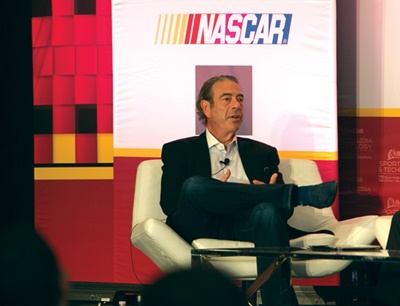What stood out to me from our Sports Media & Technology conference held earlier this month in Manhattan Beach, Calif.:
■
The Twitter Experiment
Advertisers are griping about Twitter’s low NFL viewership figures, which are coming in well below expectations. But sports media’s top executives say any focus on streaming numbers misses the main point of the deal.
Twitter’s NFL deal is one of the top sports media storylines this fall, and it came up on several panel sessions during the conference. Just about every executive who discussed the one-year deal said they viewed it as an “experiment” that will lead to significant changes to how consumers watch sports.
“The concepts being pioneered there are, in fact, part of the future,” said Los Angeles Clippers owner Steve Ballmer, who is an investor in the social media company.
None of the executives believed that Twitter’s NFL streams have had an effect on “Thursday Night Football” television viewership, which is down a double-digit percentage on CBS and NFL Network so far this season. The early streaming statistics support that viewpoint. Twitter’s average minute audience — which ranges from a low of 243,000 in Week 2 to a high of 327,000 in Week 3 — still is too small to affect television viewership, which averages in the tens of millions of viewers per game.
The NFL’s executive vice president of media, Brian Rolapp, said early returns are showing that Twitter’s audience is much younger and more mobile than the NFL typically sees from its television networks.
“The whole idea going in there is that we wanted to create something that was incremental to television,” he said. “Those statistics plus the usage numbers tell us that it was incremental to television.”
 |
NFL’s Brian Rolapp: Twitter’s NFL audience younger, more mobile.
Photo by: TONY FLOREZ PHOTOGRAPHY
|
Twitter’s top sports executive added that the social media company’s NFL audience so far has been filled with people who would not have been watching traditional TV.
“Our experience can be additive and complementary to the experience people are used to on television,” said Laura Froelich, Twitter’s head of sports content partnerships. “We are a more mobile culture these days. People need different options. They’re not always able to watch it on TV.”
The idea that digital streams can help drive TV ratings is not new. That’s been the experience of several TV networks that have streamed programming.
“There are customers that are no longer in the bundle,” said Eric Ratchman, executive vice president of content distribution for Univision. “Twitter is a place where, perhaps, you could access those viewers. We’ve put some games out on a promotional basis and we found that our TV ratings hold firm and our app viewership holds firm. And we access some incremental customers. They tend to not be the most passionate fans. The question is whether you can monetize them the same way.”
David Preschlack, president of NBC Sports Regional Networks, said TV channels need to start embracing these types of disruptions regardless of whether they hit linear TV viewership.
“Consumers are going to dictate how it is that they want to view content,” he said. “We have to embrace where fans are going and give them content and serve up content in a way that’s reflective of their lifestyle, as opposed to what we’ve done in the past.”
As for Twitter’s specific NFL offering, Activision Blizzard Chairman Steve Bornstein said he has been more impressed with Twitter’s video quality than the interactivity it provided.
“It was great. It looked like TV,” he said. “I don’t know what they were going for, but it looked like TV.”
In making the deal, Rolapp said the league made sure the video quality would remain high.
“That’s the point,” he said. “I want the quality of the stream to look like television. Of all the things we heard from fans, no one said ‘This picture is bad.’ … That’s the No. 1 hurdle for digital distribution.”
■ Sports Media: 2020
A favorite topic at media conferences like this looks into when digital media companies will open their wallets and compete for sports rights.
Bornstein said it’s already happening, adding that he’s been particularly interested in how social media companies like Facebook and Snapchat, in particular, are moving into video.
 |
Activision Blizzard’s Steve Bornstein is impressed with Twitter’s video quality on NFL games.
Photo by: TONY FLOREZ PHOTOGRAPHY
|
“Five years ago, I don’t think anybody in Silicon Valley would have paid for premium content — they were still selling the ‘technology is king’ solution,” he said. “In the last two or three years, they’ve been really paying attention to premium content — and not just in sports.”
One hold-up comes down to whether digital media companies can produce games with the same quality as broadcasters, Rolapp said.
“Some of the Silicon Valley guys need to build that capability if they want that model at some point, and I don’t know if they do,” Rolapp said. “You need a partner who values your content and wants to treat it as a crown jewel.”
Rolapp said that was one of the reasons the league had CBS and NBC produce “Thursday Night Football” games, even when they are on NFL Network exclusively.
“That was an important part of the negotiation,” he said. “We have a group full of people who know how to produce these things. It is hard. We ultimately said the ‘Thursday Night Football’ product would be better off if we actually had one of our broadcast partners do it.”
■ Saber Rattling
I was surprised that the comments Fox Sports President Eric Shanks said about the Big 12 didn’t get more play. The college conference has been kicking around the idea of adding two or four teams, which would trigger a contract clause that would force Fox and ESPN to pay a higher rights fee.
Shanks essentially warned that any expansion could wind up being a fatal decision for the conference.
Shanks: “We don’t think expansion in the Big 12 is a good idea for the conference. We think it will be dilutive to the product in the short term. In the long term, it’s probably harmful to the future of the conference. Who knows where expansion is going to go. Reading the smoke signals, [expansion talk has] cooled off. I don’t know why. We’re still in discussions with them. We still have a long way to go in the deal. We’ll work through it the best way that we can.”
■ Hot Takes
I asked Jamie Horowitz, president of Fox Sports National Networks, to explain his network’s decision to shed its news-gathering operation in favor of opinion-based studio programming.
His response: “It’s misreported that we’ve left this space of discussing the news in an interesting way. We are discussing the news of the day. You’re still getting the news of the day. In addition, you get an interesting take on it. There seems to be an insatiable appetite for consumers to hear interesting, incisive takes on the day’s news. This is not dissimilar to what you’re seeing in the news space. It’s just now in the sports space, as well.
As examples, Horowitz referenced two viral videos — one 3 1/2-minute video of Katie Nolan last October, where she described her frustration at Greg Hardy, soon after the former Dallas Cowboy player returned from a suspension for allegedly assaulting his ex-girlfriend; and a nearly eight-minute video of Shannon Sharpe passionately discussing Colin Kaepernick’s anthem protest.
“These were far more substantive than anything you’d see on a traditional news and information show,” he said.
John Ourand can be reached at jourand@sportsbusinessjournal.com. Follow him on Twitter @Ourand_SBJ.






